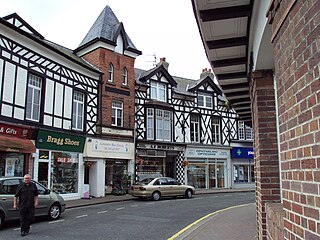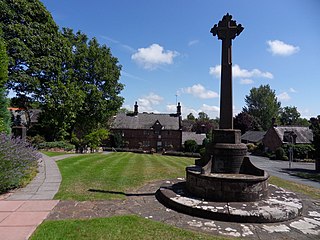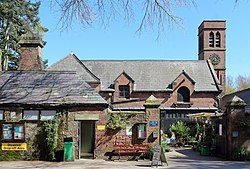
Railway modelling or model railroading is a hobby in which rail transport systems are modelled at a reduced scale.

West Kirby is a coastal town in the Metropolitan Borough of Wirral in Merseyside, England. The town lies close to the mouth of the River Dee.

Irby is a village on the Wirral Peninsula, in Merseyside, England. The village covers an area of 20 square kilometres. To the north of Irby lies the associated hamlet of Irby Hill. It is part of the Greasby, Frankby and Irby Ward of the Metropolitan Borough of Wirral and is within the parliamentary constituency of Wirral West.

The Wirral Peninsula, known locally as The Wirral, is an area in North West England. The roughly rectangular peninsula is about 15 miles (24 km) long and 7 miles (11 km) wide and is bounded by the River Dee to the west, the River Mersey to the east, and the Irish Sea to the north.

Wirral West is a constituency represented in the House of Commons of the UK Parliament by Margaret Greenwood of the Labour Party since 2015.

The Wirral Country Park is a country park on the Wirral Peninsula, England, lying both in the Metropolitan Borough of Wirral in the county of Merseyside and in the borough of Cheshire West & Chester in the county of Cheshire. It was the first designated country park in Britain, opening in 1973.

Caldy is a small, affluent village on the Wirral Peninsula, England, south-east of West Kirby. It is part of the West Kirby & Thurstaston Ward of the Metropolitan Borough of Wirral and is in the parliamentary constituency of Wirral West. At the time of the 2001 Census, Caldy had 1,290 inhabitants, of a total ward population of 12,869.

Bidston Hill is 100 acres (0.40 km2) of heathland and woodland containing historic buildings and ancient rock carvings, on the Wirral Peninsula, near the Birkenhead suburb of Bidston, in Merseyside, England. With a peak of 231 feet (70 m), Bidston Hill is one of the highest points on the Wirral. The land was part of Sir Robert Vyner's estate and purchased by Birkenhead Corporation in 1894 for use by the public.

Greasby is a large village on the Wirral Peninsula, Merseyside, England. A predominantly residential area, it is contiguous with Upton to the east and Saughall Massie to the north. The small village of Frankby is to the immediate west. Historically within the county of Cheshire, it is part of the Greasby, Frankby and Irby Ward of the Metropolitan Borough of Wirral and is in the parliamentary constituency of Wirral West.

A ridable miniature railway is a large scale, usually ground-level railway that hauls passengers using locomotives that are often models of full-sized railway locomotives.

Thurstaston Common is an area of almost 250 acres (100 ha) of parklands, wood and heath between Frankby and Thurstaston, on the Wirral Peninsula in North West England. The common is jointly owned by the National Trust and the Metropolitan Borough of Wirral. Royden Country Park is nearby and offers additional facilities.

Thurstaston is a village on the Wirral Peninsula, Merseyside, England. It is part of the West Kirby and Thurstaston Ward of the Metropolitan Borough of Wirral and the parliamentary constituency of Wirral West. The village lies on the A540 road between Heswall and Caldy, although it extends some distance down Station Road to the Wirral Way and the River Dee estuary.

Frankby is a village on the Wirral Peninsula, in Merseyside, England. It is located between Greasby and Newton on the outskirts of the town of West Kirby. The hamlet of Larton is to the north west. Historically within the county of Cheshire, it is part of the Greasby, Frankby and Irby Ward of the Metropolitan Borough of Wirral and is in the parliamentary constituency of Wirral West.

Newton is a village on the Wirral Peninsula, in the Metropolitan Borough of Wirral, Merseyside, England. It is a part of the suburban town of West Kirby, the local government ward of West Kirby and Thurstaston and the parliamentary constituency of Wirral West. Contiguous with Newton is the suburb of Grange to the west. The hamlet of Larton is to the east.

Hill Bark Farmhouse is to the east of the house of Hill Bark, and south of the hamlet of Frankby, Wirral, England. It is recorded in the National Heritage List for England as a designated Grade II listed building.

Hill Bark is a large country house to the south of the hamlet of Frankby, Wirral, Merseyside, England. It is recorded in the National Heritage List for England as a designated Grade II* listed building. The authors of the Buildings of England series comment that it is "one of the most notable Victorian essays in half-timbered design anywhere in the country".
Hoylake is a seaside town in Wirral, Merseyside, England. It contains 41 buildings that are recorded in the National Heritage List for England as designated listed buildings. Of these, two are listed at Grade II*, the middle of the three grades, and the others are at Grade II, the lowest grade. The list includes listed buildings in the town of Hoylake, and in the surrounding villages and areas of West Kirby, Caldy, Frankby, Meols, Grange, and Hilbre Island. In the list are houses and churches with associated structures, a telegraph station, a well house, a lighthouse, a village hall, banks, a drinking fountain, a war memorial, and a railway station.




















